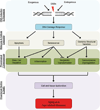Do DNA Double-Strand Breaks Drive Aging?
- PMID: 27588601
- PMCID: PMC5012315
- DOI: 10.1016/j.molcel.2016.08.004
Do DNA Double-Strand Breaks Drive Aging?
Abstract
DNA double-strand breaks (DSBs) are rare, but highly toxic, lesions requiring orchestrated and conserved machinery to prevent adverse consequences, such as cell death and cancer-causing genome structural mutations. DSBs trigger the DNA damage response (DDR) that directs a cell to repair the break, undergo apoptosis, or become senescent. There is increasing evidence that the various endpoints of DSB processing by different cells and tissues are part of the aging phenotype, with each stage of the DDR associated with specific aging pathologies. In this Perspective, we discuss the possibility that DSBs are major drivers of intrinsic aging, highlighting the dynamics of spontaneous DSBs in relation to aging, the distinct age-related pathologies induced by DSBs, and the segmental progeroid phenotypes in humans and mice with genetic defects in DSB repair. A model is presented as to how DSBs could drive some of the basic mechanisms underlying age-related functional decline and death.
Copyright © 2016 Elsevier Inc. All rights reserved.
Figures


References
-
- Barlow C, Hirotsune S, Paylor R, Liyanage M, Eckhaus M, Collins F, Shiloh Y, Crawley JN, Ried T, Tagle D, et al. Atm-deficient mice: a paradigm of ataxia telangiectasia. Cell. 1996;86:159–171. - PubMed
-
- Barnes DE, Lindahl T. Repair and genetic consequences of endogenous DNA base damage in mammalian cells. Annu Rev Genet. 2004;38:445–476. - PubMed
Publication types
MeSH terms
Substances
Grants and funding
LinkOut - more resources
Full Text Sources
Other Literature Sources
Medical
Research Materials
Miscellaneous

